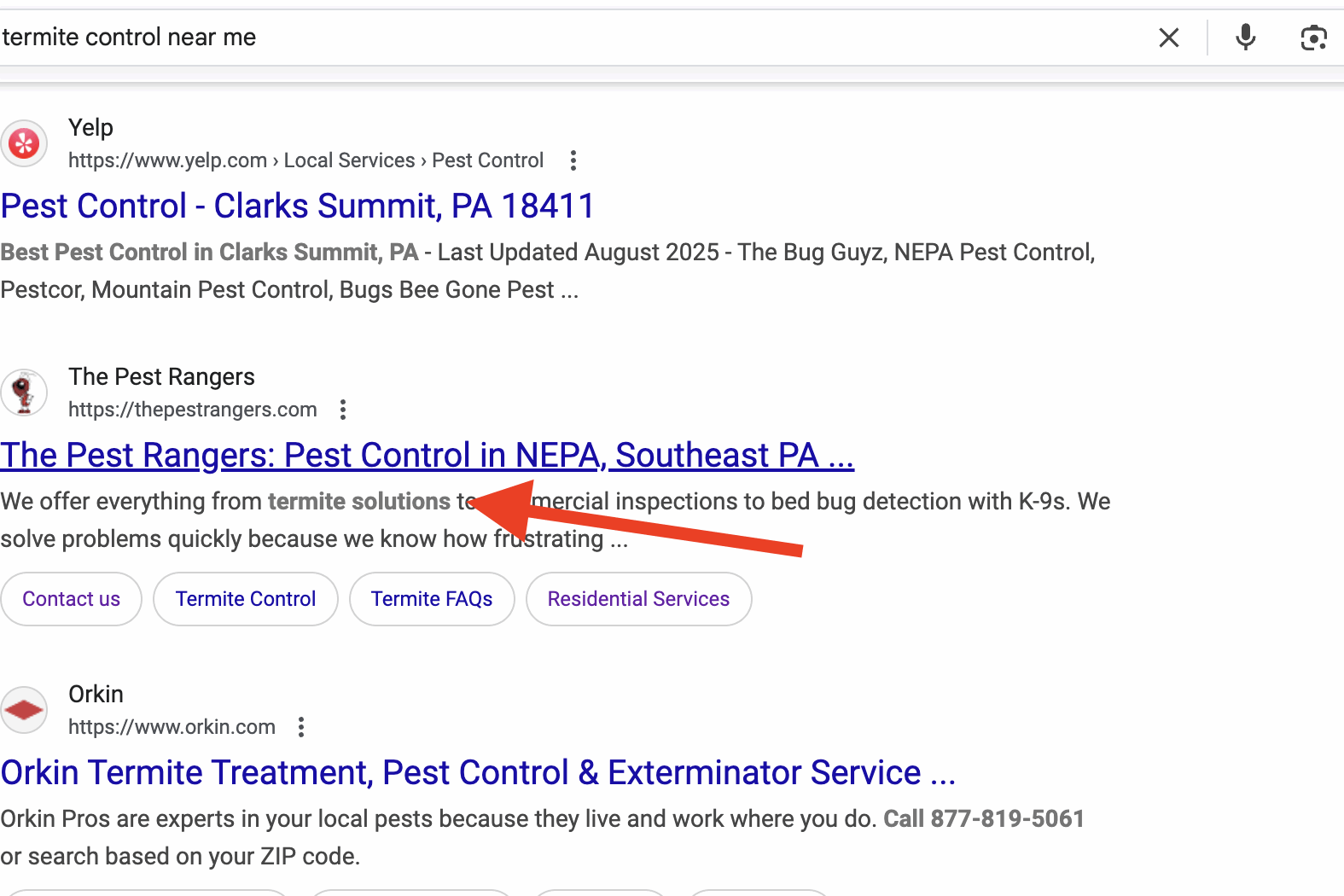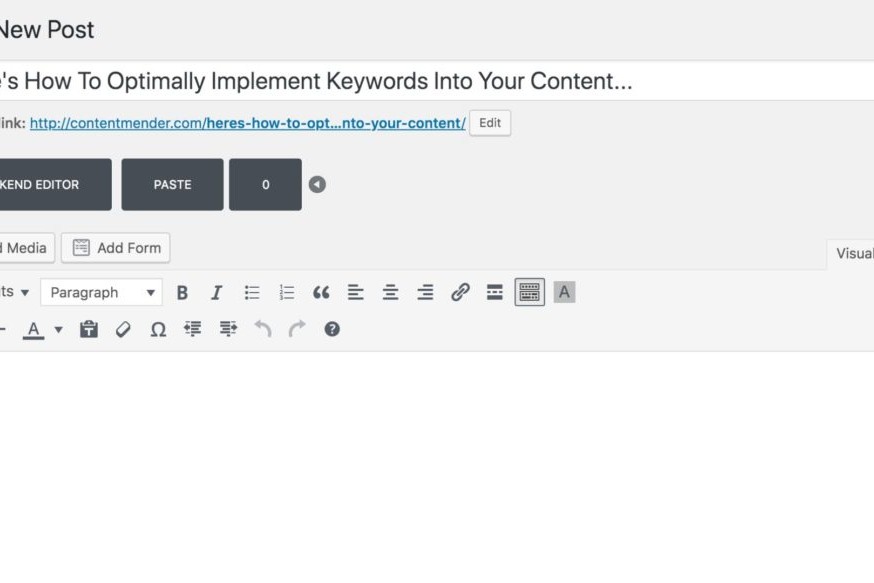SEO is a critical part of any online business strategy. One way to maximize the potential of your SEO strategy is to localize it for customers in your geographic region.
What Is Local SEO
Local SEO is a digital marketing strategy designed to position your website to rank for geographic-specific or “near me” searches.
Local SEO differs from traditional SEO by its emphasis on local and geographically based keywords. For example, a large chain like Dicks Sporting Goods might focus on search terms, such as “sports equipment,” while a local baseball shop might optimize its website for terms, such as “sports stores Austin.”
Nonetheless, local SEO incorporates all of the same strategies as traditional SEO, except with a geographic focus.
Search engines automatically consider the geographical location of the user if they have their location enabled. In turn, your website will be more likely to show up in local 3-pack search results and Google’s SERPs for local search terms or “near me” searches.
However, other factors will influence a user’s local results, such as distance, reviews, and hours.
For instance, if you search for “pizza restaurants in Old Forge pa,” Google provides different results than a “near me” search conducted one town away for “old forge pizza.”.
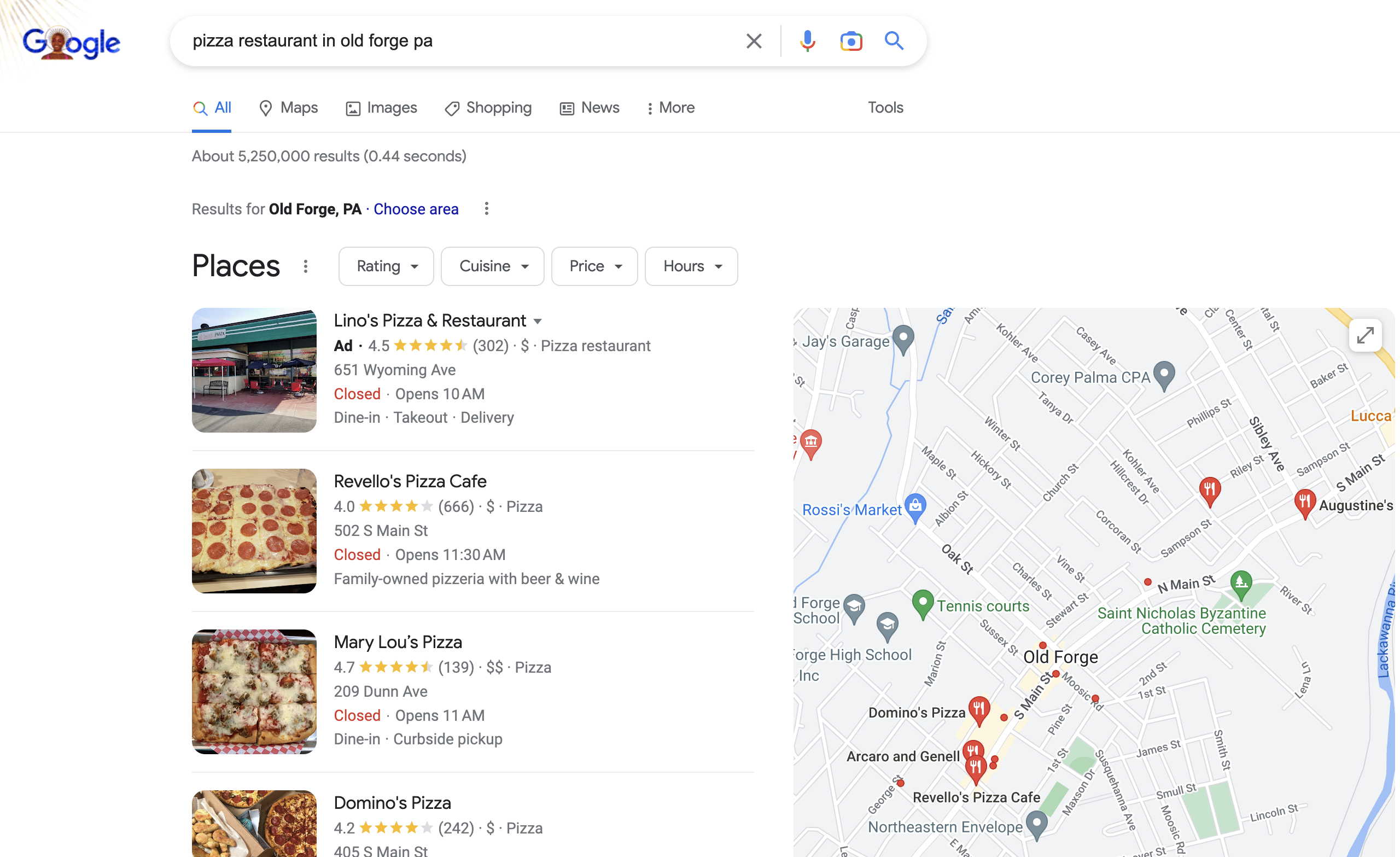
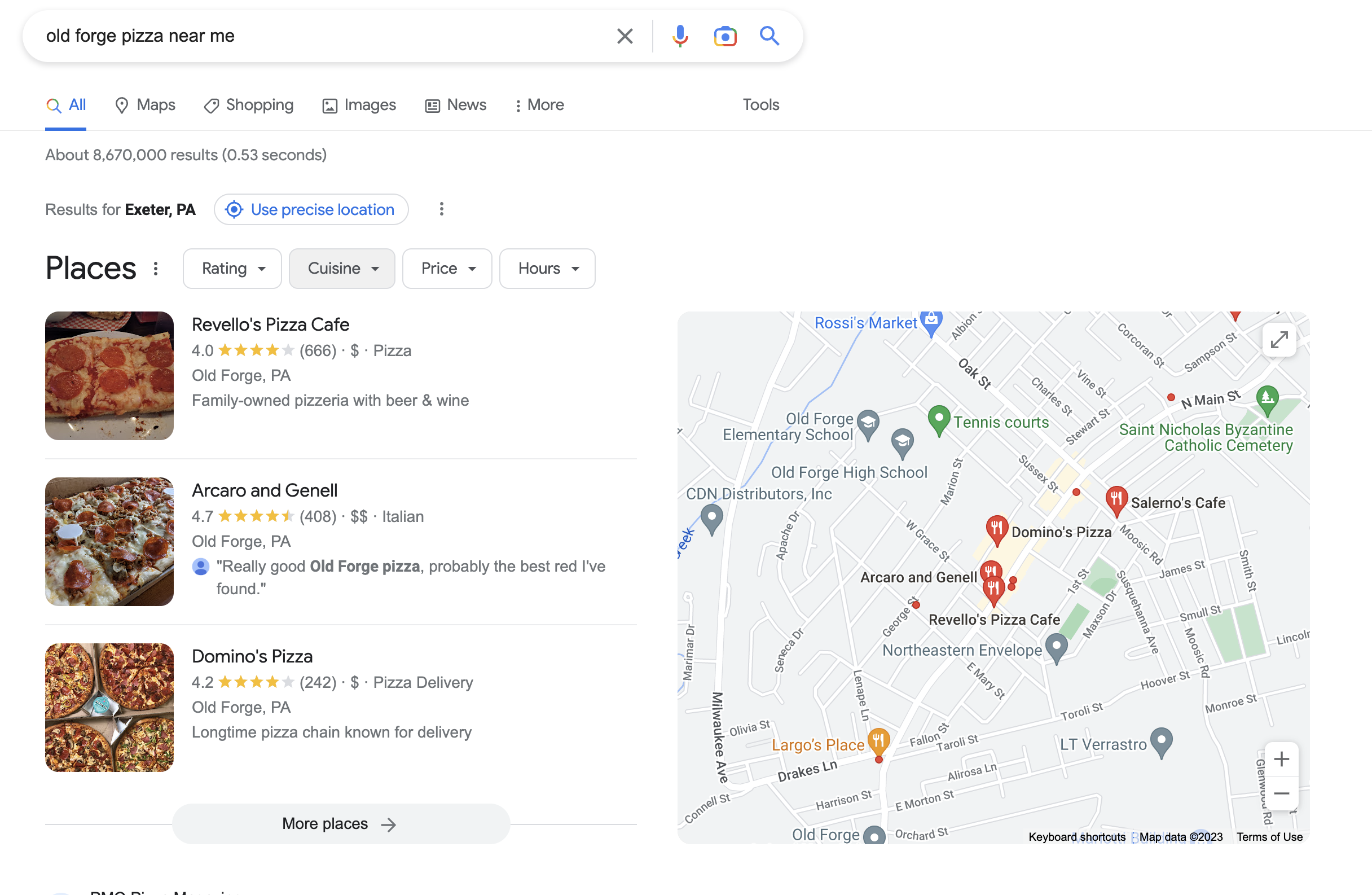
Search engines use location-based data (IP addresses and geolocation) to provide results that matter the most to their end users. By optimizing your website for small localities, you can improve online visibility within the local search results.
Reminder: You can increase the chances of getting listed at the top of a SERP and receive higher CTRs (click-through rates) by focusing on user intent for every search query.
Why Is Local SEO Important
According to NPR, 56 percent of online shoppers say they still appreciate the in-person experience over digital retailers.
Furthermore, Safari Digital found that 46% of online searches involved location-based queries.
Local SEO is not about replacing the traditional brick-and-mortar experience. Instead, it strengthens it.
Furthermore, local SEO allows businesses to scale at a very low cost until they are financially solvent enough to compete at a larger regional or national level.
In sum, the benefits of local SEO for businesses include:
- Increased local visibility (over the web and in-person)
- Greater qualified traffic by focusing on local users
- Higher conversion rates
- Lower-cost marketing and advertising rates
- Providing users easy access to contact your business
- Convenient online ordering and shopping services
Who Needs Local SEO Services?
Essentially, any business with a local presence or franchise presence can benefit from local SEO.
In many ways, the strategies we will outline for local SEO will also benefit your franchise SEO strategy as well.
Local SEO is not restricted to physical businesses either, as online services companies or businesses that participate in coworking spaces can benefit from engaging locally.
Now that you understand the simple concept of Local SEO, here’s how to optimize yours for the best results.
Local SEO Checklist
1. Local Keyword Research
Advanced keyword research is an essential part of any SEO strategy, except our focus will be on geographically specific keywords.
For example, if I was operating a barbershop out of Brooklyn, I would create a list of seed keywords related to my business and location, including:
- barbershop brooklyn
- brooklyn barbershop
- gentleman’s barbershop in brooklyn
- mens haircuts brooklyn
- brooklyn fade haircut
Reminder: Local SEO can also include your county, region, or any other words/phrases associated with your area (e.g., Northeastern Pennsylvania is known as NEPA).
Afterward, you can use your keyword research tool and upload all relevant keywords to a spreadsheet that you will use to input your content.
Here’s a quick rundown of steps you’ll need to take:
- Create your keyword list, paying attention to monthly search volume.
- Use a keyword tool (Google Keyword Planner, SEMrush, etc.) and add the seed keywords to find new keyword ideas and get the estimated search traffic for highly relevant targeted keywords.
- Filter down a list of targeted keywords with reasonable search volume and demonstrate medium to low competition levels.
- Optimize content for those keywords, starting with the title tag explained next.
2. Title Tags & Meta Descriptions
Your title tag is one of the most popular factors in strengthening your on-page SEO.
People can easily locate it at the top of the browser tab. Optimizing your title tag allows Google bots and users to get a fair insight into what to expect after clicking the link and helps your page index for specific keywords.
Title Tag Best Practices
- Always include target keywords to describe the page
- Place the keyword at the beginning itself
- Do not extend the length beyond 60 characters to get full display on SERP
- Include brand name if possible

Next is the meta description–the short snippet (<160 characters) of information visible in the search engine results pages.
Google does not use the meta description as a ranking factor, but these descriptions do provide an indirect ranking factor. For example, the meta description may impact your click-through rate.
Plus, as you notice in the example above for the query “old forge pizza,” those words are bold and attract the eye. That’s why you always use the target keyword in the meta description.
Meta Description Best Practices
- Keep it unique, informative, and interesting.
- Keep it limited to 140-160 characters (not words!)
- Use your target keyword
- Do not stuff with keywords
3. NAP Information – Name, Address, and Phone Number
Your NAP plays an important role in your local SEO and UX. For one, search engines tend to use your NAP to rank for geo-specific search queries.
Secondly, NAP consistency is critical to providing a smooth user experience. For example, if you had a different address listed on your homepage and contact page, this would cause great confusion to your audience and harm your business.
We recommend displaying your official business name, address, and phone number in your website’s header or footer section to establish transparency with Google and your users and gain market confidence.

Want to learn some writing strategies that will help grow your client base? Read our founder’s book: 365 to Vision: Modern Writer’s Guide (How to Produce More Quality Writing in Less Time). Click on the image above to learn more.
4. Image Optimization
Images are an integral element of your local SEO world.
First, images are a great marketing asset. How many times have you clicked on a restaurant’s images in its reviews or on its website for a peak at what the food looks like?
Secondly, image SEO is a vastly undervalued traffic channel for many businesses.
When you search for an image, Google relies on an alt attribute, referred to as alt text. Optimizing this attribute with keyword-specific terms will help images on your website rank for those keywords in Google’s image search.

Image SEO Best Practices
- Filename: Title your image with your target keyword.
- Title: You can read the text if you put the cursor on the image. Basically, this describes the text and must contain your main keyword or any near variation.
- Alt-Text: Optimize this text with a target keyword to help it rank in image searches.
- Image Size: Resize and compress your image before uploading to the website.
- Format: Certain image formats are preferred by search engines and user browsers.
5. Include Google Maps in the Contact Information Page
Having a google map is another strong signal about your business location to search engines and users.
All you have to do is visit Google Maps, click on the top left menu, and “add your business”; follow all the instructions to complete the steps. Additionally, it helps your users to track your exact location from their current position.
6. Update Your “Google My Business” Page (GMB)
Google My Business is a free and useful tool for companies vying to rank better for local search engine rankings. Create your business account and update all the important information that includes but is not limited to the business name, location, contact number, email, business category, and more.
The job does not end here. You have to get your business verified through the mail.
Afterward, visit the GMB dashboard and add as much relevant information as possible, such as:
- Where you serve
- Any relevant images
- Products/services offered
- Business updates and announcements
You can also request your customers to share reviews on your GMB profile for other visitors to read.
7. Schema ( or Structure Data Markup )
Schemas help search engines understand your location-based structured information such as your NAP – business name, addresses, dates of events, phone numbers, and many more.
Depending on the type of local business, you should use the appropriate schema. You can read more information about local business schemas from Google and also from schema.org.
Generally, there are three supported formats to write schema markup for websites:
- JSON-LD (recommended)
- Microdata
- RDFa
However, before adding Schema markup, run it in Google’s Structured Data testing tool to test its validity.
Remember, just because you’ve added structured data, it does not guarantee that it will appear in the SERP for local queries. Follow the structured data guidelines to ensure you input this data correctly so it can boost your rankings.
8. Public Citations and Directories
Citations are an online mention of your business anywhere on the web. A single citation registers the presence of your NAP and gives a valuable link back to your business.
However, not all citations are created equal and largely depend on several variables, including the relevance of your citation source. For example, a plumber with a citation in a North American directory for doctors will do nothing for their business and might even be seen as spam.
Finding hyper-local directories can be hard but pursue extensive research online to find highly relevant citation sources (or websites). Many tools, such as Moz, offer local citation tools to get you started.
Be sure to get citations on relevant sites, such as Yelp, Yellow Pages, the Better Business Bureau, Angie’s List, etc.
Local Citation and Directory Best Practices
- Maintain and update NAP consistency.
- Add a unique business description that gives succinct information about your company (i.e., history, locations, products, services, etc.).
- Upload relevant, high-quality images describing your business.
- Use one citation link per location and remove multiple copies, if any exist.
- Determine relevant categories for your business. Do not overdo this and limit it to 3-4 categories.
9. Social Media Optimization
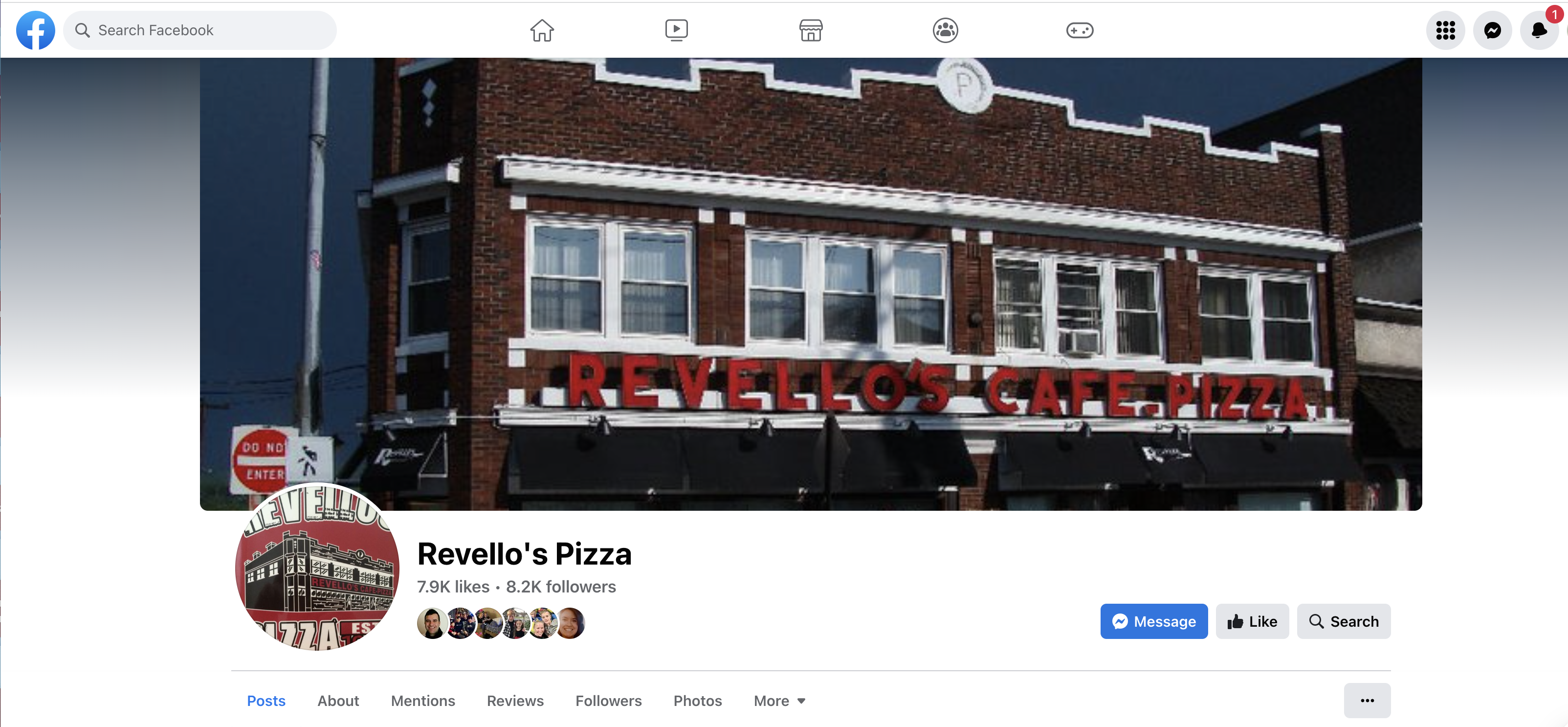
Social media can be so much fun and rewarding for your business if you carefully watch every single step.
Create a profile for your company on popular social media sites like Facebook, Instagram, Twitter, and LinkedIn.
Do not consider them as isolated parts; instead, incorporate them as if they’re an extension of your business’s individual landing pages.
Likewise, social profiles are important for your business to garner buzz across Facebook, Twitter, Instagram, etc. Many studies suggest that social media influences users’ opinions and can build organic traffic to your website.
10. High-Quality, Engaging Content
Creating informative and compelling localized content is a great tactic to engage with local customers and build up your brand’s influence and thought leadership.
Utilize your keyword research and make sure to segment your keywords for informative intent.
Write about broad topics related to your industry or local topics that appeal to natives of your area.
Other local content marketing ideas include organizing local charity events and sponsorships to write about and market to people across all of your local channels.
Just be sure to learn how to optimize content for search engines to maximize its effectiveness.
11. Local Backlinks
Be sure to promote your content using local link-building tactics. Backlinks are not only a valuable source of qualified and referral traffic but also a core ranking factor in Google’s algorithm.
Local link building will involve a lot of manual outreach to local bloggers, businesses, and journalists to promote your business or any content you write. Be sure to write a formal outreach letter and emphasize that your outreach is to benefit their customers, not strictly as a quid pro quo deal.
Local Link-Building Strategies
- Reclaim broken links using a tool like SEMrush.
- Use a site operator search to find local resource guides and pages and reach out for a link to your business.
- Use HARO to respond to local news stories as a commenter.
- Guest post on local blogs to promote your thought leadership.
- Create local events that produce a buzz in the community.
- Sponsor a business or event that forces people to link to your website.
- Leverage competitor link-building strategies.
12. Anchor Text Optimization
Just as important as inbound links are internal links.
Internal links allow websites to facilitate link equity across their site and promote greater visibility for their pages. Additionally, these links aid in user experience by providing users with another page on your site to engage with for further information.
One way to leverage your keyword research in this strategy is by optimizing the anchor text to rank a hyperlinked page for the bit of text being linked.
A word of caution; do not spam your anchor text. For example, if your anchor text says “Home Plumbers,” but it’s directed to a home decor page, it misguides the users and Google alike by using improper anchor text.
Internal Linking/Anchor Text Best Practices
- Make anchor text as natural and relevant as possible
- Avoid spamming the page with the same anchor text–avoid over-optimization
- Do not link to spammy or adult sites
- Distribute anchor text variations
- Place anchor text where it grabs eyeballs and not where it is of little help.
13. Online Reviews
Online reviews are an integral part of your local SEO and Google My Business strategy. Not only do reviews impact local 3-pack results, but nearly 50% of internet users trust reviews the same way they do personal recommendations.
Consider asking users to rate your business and website online very organically.
Using reviews and testimonials as a marketing tactic for landing/nurture pages is also a great strategy to convert more leads.
14. Local Engagement and Outreach
Engaging with local customers in the community is a surefire way to promote your brand beyond traditional marketing channels.
Consider the following strategies in tandem with your content marketing and link-building strategy to build awareness for your brand.
- Partner with a business
- Hold a fundraisers
- Make a charitable donation
- Host or sponsor an event
- Buy a local business
- Host a press conference
15. Mobile-Friendliness
Finally, we can’t forget to mention the importance of mobile-friendliness. As that previous study pointed out, almost half of online searches are for geographically-specific queries.
In sum, many people search for businesses and their contact information using their mobile phones. Providing sufficient NAP information and a fast-loading website will help prevent bounce rates and abandoned leads.
Be sure to build your website with responsive web design and test your mobile page speed using Google’s Page Speed Insights. This tool will provide helpful tips to resolve issues plaguing your website’s speed and usability.
Lastly, we should note that page speed plays a minor role in Google’s search algorithm.

Local SEO is an easy and reliable strategy to increase leads to your website and build local visibility. Use these strategies along with other traditional strategies to maximize your reach and become better established within your community.
Work with a local SEO company or white-label services that specializes in local SEO to help you get started and get your business off of the ground.


